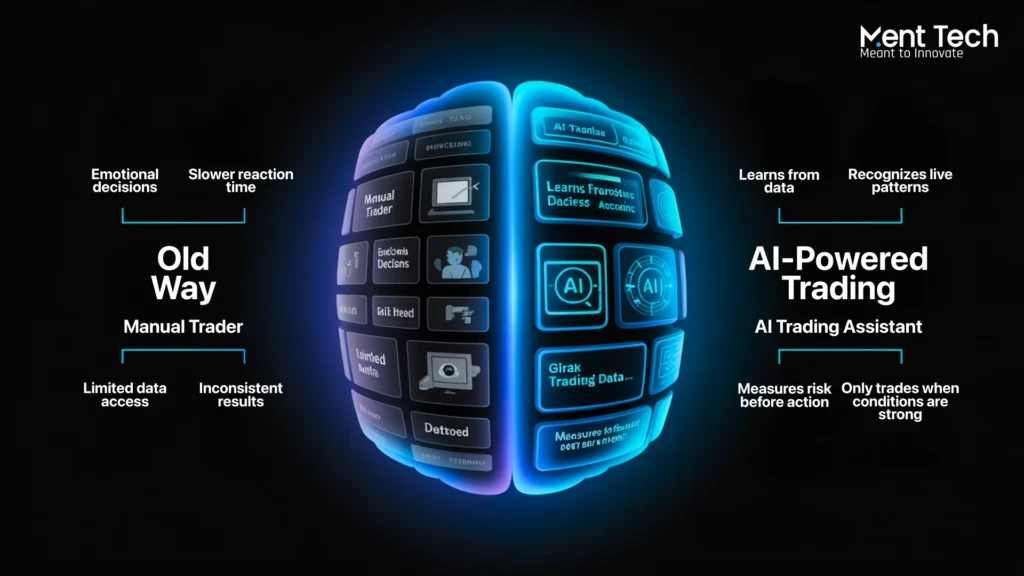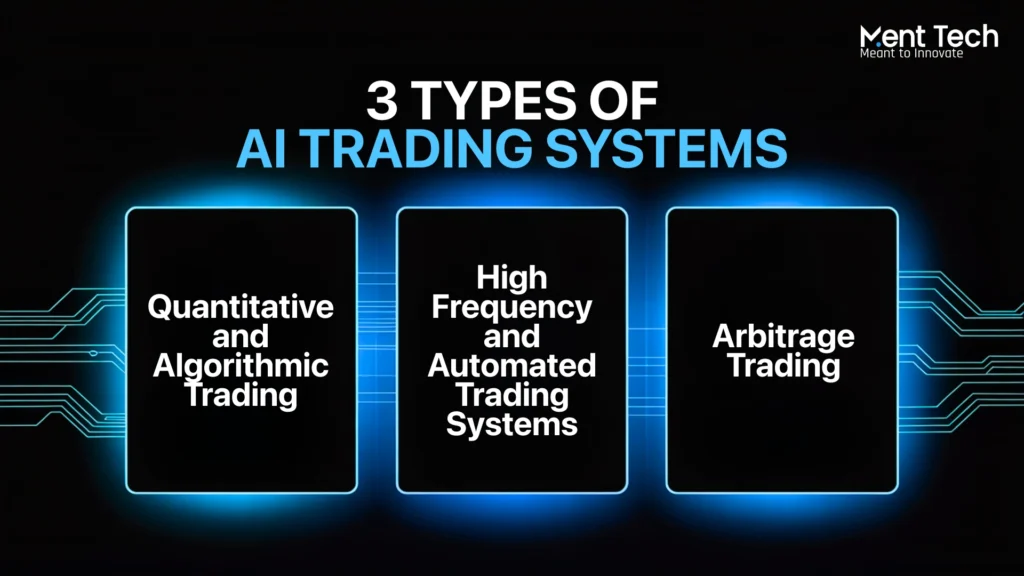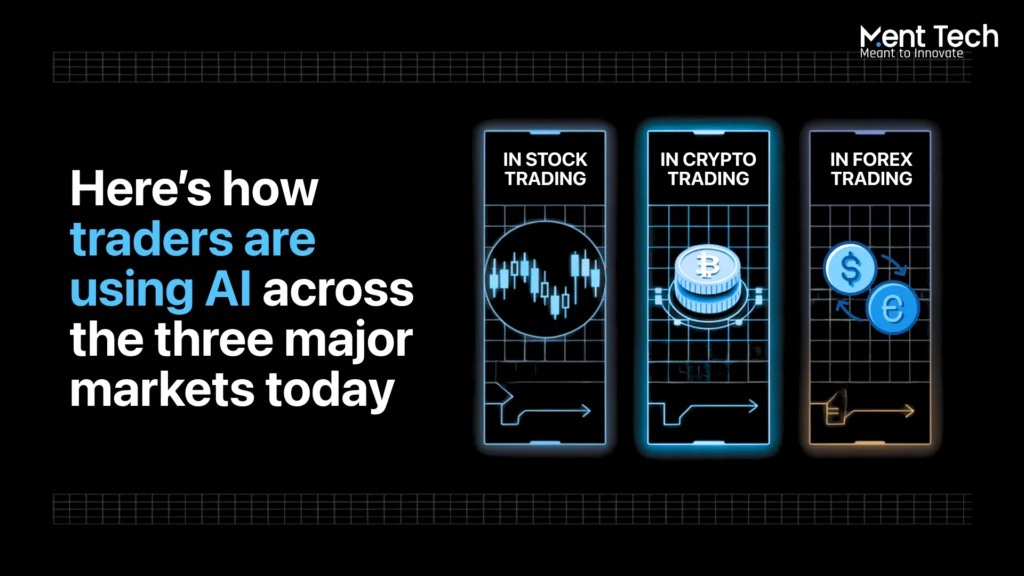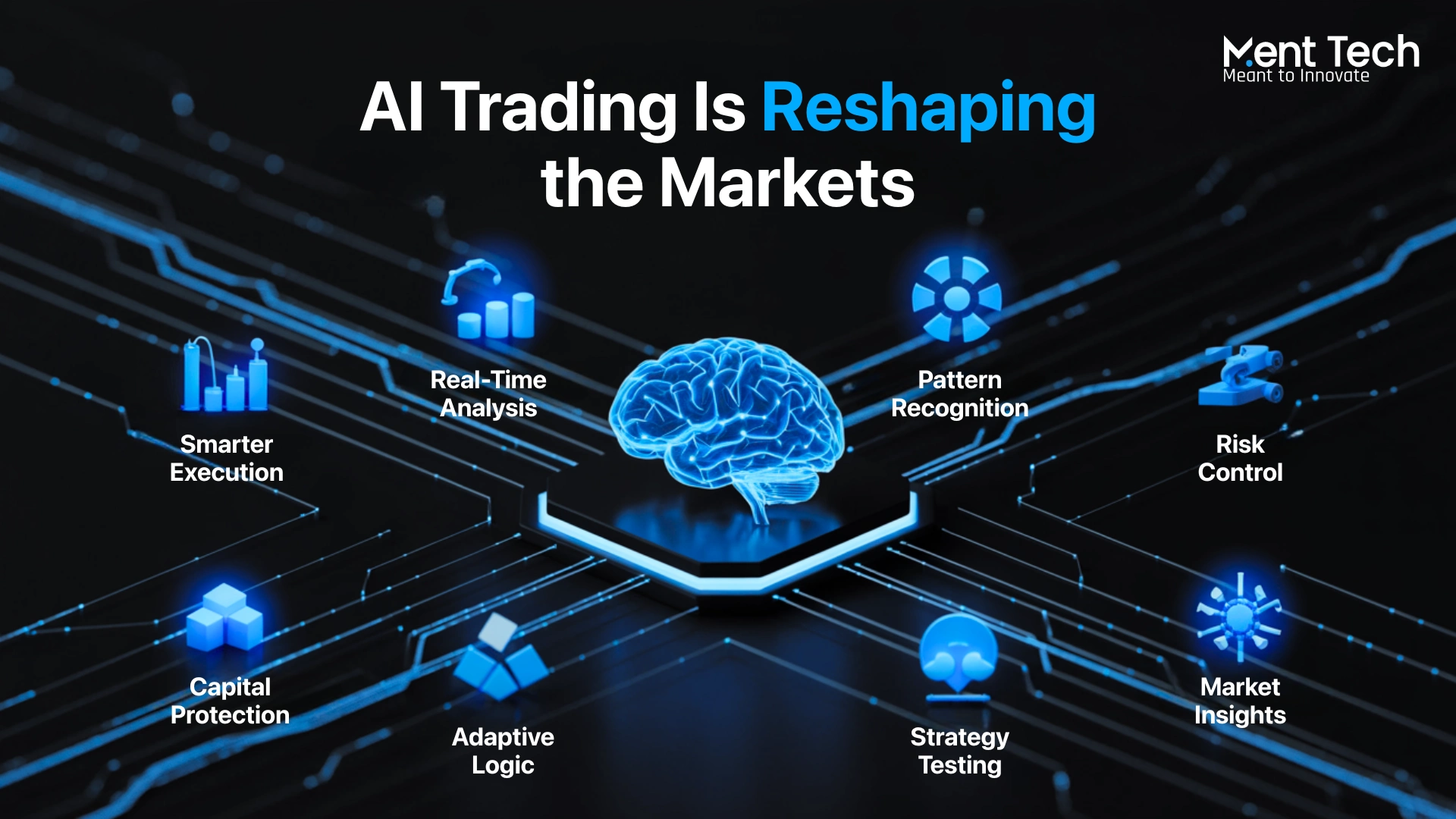The way we trade has changed, smart algorithms and expert AI development services now help traders make faster, clearer decisions backed by real data. AI trading systems use real-time data, machine learning, and predictive models to analyze market trends and execute trades across stocks, crypto, and forex with precision.
These bots remove emotion, react instantly, and adapt to changing conditions, something manual traders struggle to match. From scanning price mismatches in crypto to managing volatile forex pairs, AI is reshaping how markets are approached. With the AI trading software market exceeding $18 billion, it’s clear that intelligent, risk-focused platforms are now essential tools for serious investors.
What Is AI Trading?
When people hear the term AI trading, they often imagine fully automated systems making trades without any human involvement. But there’s more to it. At its core, AI trading is about using software that can learn from data, recognize patterns, and make trading decisions based on logic instead of emotion.
AI trading uses machine learning, real-time data, and statistical models to make smart, fast trading decisions. Unlike rule-based systems, it learns from market patterns and acts only when conditions are right. Tools like AI trading bots for stocks, crypto, and forex help spot high-quality trade setups with precision. As volatility rises, more traders are turning to AI as a service to access powerful models without building them from scratch.

How Does AI Stock Trading Work?
1. Smart Data Collection: AI trading systems gather real-time data from charts, news, and social media. This gives AI stock trading bots a comprehensive market view.
2. Pattern Recognition with Machine Learning: Artificial intelligence in trading spots trends and signals that humans often miss. This powers smarter, faster decisions in volatile markets.
3. Predictive Price Modeling: Ever wondered if technology can predict stock prices? With smart systems that learn from past trends and real-time data, it’s now possible to forecast market moves more accurately than ever using patterns and logic.
4. Instant Trade Execution: Algorithmic trading with AI means trades are executed instantly with no hesitation and no emotional errors, just high-speed logic.
5. Continuous Strategy Optimization: Adaptive AI solutions adjust strategies based on live market shifts. This is how the best AI trading software keeps winning.
6. Risk Management Automation: AI sets intelligent stop-loss levels and manages position sizes. It’s one of the biggest benefits of AI in trading today.
7. Scalable AI for Everyone: From individual traders to global AI startups, AI as a Service for businesses makes powerful tools accessible without building from scratch.
Types of AI Trading Systems
Not all AI trading systems are built the same. While the term AI trading often brings to mind bots running trades on autopilot, there are different types of systems used across stock, crypto, and forex markets. Each one serves a different purpose depending on how much control, automation, and risk management a trader wants.
Many AI startups are now focusing on building specialized trading systems, from predictive analytics tools to adaptive trade assistants, to meet the evolving needs of modern investors. These innovations are helping traders gain an edge in volatile markets by offering smarter, more personalized automation.
Let’s break down the major types of AI-driven trading systems and how they work.

AI-Enhanced Algo Trading
- Combine rule-based strategies with AI models to optimize entries, exits, and risk in real time.
- Ideal for traders who want traditional algorithms to adapt dynamically to changing market conditions.
ML-Powered Trading Systems
- Use deep learning and pattern recognition to discover hidden trends and predict price action with higher precision.
- Continuously evolve by learning from market data, minimizing human bias in strategy building.
Specialized AI Trading Bots
- Designed for specific assets like crypto, forex, or commodities, these bots handle unique market behaviors with tailored intelligence.
- Offer round-the-clock analysis and execution, perfect for high-frequency or volatile market environments.
Hybrid AI Trading Models
- Blend AI decision-making with human oversight, giving you the edge of automation without losing control.
- Great for professional traders who want scalable systems that still reflect their personal trading style.

Popular AI Tools Used in Trading
The rise of AI in financial markets has created an entire ecosystem of tools that traders can use to make smarter decisions. From beginners to institutional players, everyone now has access to advanced trading platforms that were once limited to hedge funds. These tools go far beyond placing trades automatically. They help with strategy development, market monitoring, portfolio management, and real-time decision-making.
As the landscape continues to evolve, AI in Web3 is opening up even more possibilities, combining decentralized finance with intelligent automation. Traders and investors are now exploring AI-driven tools that operate across DEXs, analyze on-chain data, and support decentralized trading strategies.
Let’s look at some of the most widely used AI tools in stock trading, crypto trading, and forex today.
1. Portfolio Managers
AI-powered portfolio managers help investors automate asset selection, rebalancing, and risk optimization. These tools align with your financial goals and risk profile, offering personalized investment strategies and ongoing performance monitoring without manual intervention.
2. Trading Robots
Also known as algorithmic trading bots, these tools execute trades automatically based on predefined conditions. Once set up, they operate independently, following your rules with precision and speed, minimizing emotional decision-making.
3. AI Trade Alerts
AI-generated trading signals scan live market data to detect high-probability setups. These alerts are sent via email, app, or SMS, helping traders stay informed without executing trades automatically. You stay in control while benefiting from AI-powered insights.
4. Custom Strategy Creators
Ideal for traders who want full control, these tools let you design and test strategies using historical data. You can simulate trades, analyze performance, and refine your approach before deploying it in live markets.
Use Cases of AI Trading Across Stock Crypto and Forex Markets

AI trading is being used in different ways depending on the market. What makes these tools valuable is their ability to adapt to different trading environments while keeping things structured and risk-focused.
Here’s how traders are using AI across the three major markets today:
In stock trading
- AI stock trading bots help analyze price movements volume shifts and technical setups without emotional bias
- Traders use these systems to filter out weak setups and focus only on trades with clear confirmation
- AI trading software also supports portfolio rebalancing and long term position tracking which is ideal for swing traders and investors
In crypto trading
- AI crypto trading bots are active around the clock scanning thousands of pairs across multiple exchanges
- Many traders use these bots for crypto arbitrage catching price differences and placing instant trades before spreads disappear
- These systems also monitor market sentiment track volatility and send signals only when all conditions match a trader’s strategy
In forex trading
- AI forex trading software helps traders navigate fast moving currency markets by analyzing economic events and technical indicators in real time
- These tools reduce human error during volatile sessions and improve trade execution speed
- They also maintain strict entry and exit rules which is essential in a market that reacts to global news within seconds
Across all markets, AI trading tools give traders more structure, more clarity, and more consistency. Whether it is scanning for trade setups, managing risk, or removing emotional decisions, the result is the same. Smarter tools that help protect capital and deliver better outcomes over time.
What Makes Ment Tech AI Trading Assistant Unique?
In a market flooded with copy-paste bots and generic auto-traders, most systems focus on volume, speed, or hype. But we took a different route. We built a trading assistant designed to protect capital and support real decision-making.
Here’s how our system stands apart from traditional AI trading bots and platforms:
It filters trades instead of forcing them
- Unlike most bots that send constant alerts, our assistant shows nothing unless the setup is clean
- Every trade must meet a minimum one to two risk to reward ratio and pass at least one hour of confirmation
- This helps reduce bad entries and protects your capital during sideways or choppy markets
It reads the market in real time
- Our assistant processes live charts and updates conditions second by second
- It uses over one hundred proprietary indicators combined with multi timeframe logic to ensure context driven trade signals
- This real time interpretation helps avoid setups that only look good in hindsight
It adapts to your trading style
- Whether you are a retail trader a funded account holder or running a prop firm this assistant adjusts to your risk preferences
- You can define your stop loss rules pair selection and trade size without needing to code
- The assistant grows with your performance by learning from past trades and adjusting alerts based on patterns that work for you
It focuses on capital protection above all else
- Our core logic is built to stop trades that look almost good but don’t pass the final filter
- If the market conditions are unclear, it stays quiet
- This risk first approach is what separates high performing tools from those that just generate noise
It was built in house from scratch
- This is not a forked system or a modified signal bot
- Every line of logic and every indicator used in the assistant was designed for one goal to give traders clarity and control
If you are tired of platforms that send constant alerts without logic or trade bots that overtrade without structure, this assistant might be what you have been waiting for. It helps you stay patient, protect your account, and execute trades that actually make sense.
Benefits of AI Trading
The growth of AI trading is not just about technology catching up with finance. It is about giving traders better tools to manage risk, trade more efficiently, and stay consistent across changing market conditions. Whether you are managing your capital or running client portfolios, these benefits are hard to ignore.
1. Cuts down research time
One of the biggest time drains in trading is analysis. AI trading software can process market data, economic reports, and technical patterns in seconds. Instead of spending hours reading charts and news, traders get focused insights that allow for quicker decision-making. This feature is especially valuable for day traders, swing traders, and those managing multiple assets.
2. Improves trade accuracy
AI stock trading bots and crypto trading systems do not get tired, emotional, or distracted. They follow logic and act only when conditions are met. Such behavior helps reduce impulsive entries and exits, which are often the cause of early losses. With better timing and cleaner execution, traders get closer to the kind of consistency that manual systems rarely offer.
3. Identifies patterns in real time
Good trades often come down to spotting patterns before the rest of the market does. AI trading platforms use historical data, technical signals, and price flow to identify these moments as they happen. Whether you are trading forex breakouts or crypto reversals, real-time pattern recognition gives you an edge without guessing.
4. Reduces emotional trading
Emotions are one of the biggest threats to long-term success. Fear, greed, and hesitation can lead to revenge trades, missed opportunities, or holding positions too long. AI trading bots and assistants remove this friction by following your preset logic every time. This creates a more stable trading environment where every action has a reason.
5. Helps with risk management
Risk is part of trading, but poor risk control is avoidable. Advanced AI trading software can calculate position sizing, apply stop-loss levels, and avoid overexposure based on account conditions. Some systems even stay silent when the market is not favorable, a feature that protects capital during unpredictable moves.
Final Thoughts
AI is no longer a concept of the future. It’s the foundation behind how modern trading truly works today. At Ment Tech, our AI development services power intelligent trading systems that help you act faster, manage risk better, and aim for long-term results. Built on real market behavior and strategic intelligence, our solutions help you trade with precision and purpose.
But even the smartest tools shine brightest when paired with human insight. AI can detect patterns, process massive data sets, and capture market sentiment across news and social platforms. Still, the most successful traders use these tools to strengthen their judgment, not replace it. It’s about combining speed and logic with intuition and experience.
That’s why more platforms are turning to AI development services to access advanced capabilities without starting from scratch. Whether you’re building from the ground up or scaling an existing system, Ment Tech is here to support every step. All our solutions are built in-house with full transparency, quick turnaround, and dedicated support that evolves with you.
If you’re ready to trade smarter and adapt faster, connect with Ment Tech and start building your AI trading platform today.
Frequently Asked Questions
1. What is the AI that helps with trading?
AI that helps with trading is typically referred to as AI trading software or an AI trading assistant. These tools analyze market data, identify patterns, and help traders make informed decisions. Unlike basic bots, advanced assistants like the one developed by Ment Tech Labs are built to protect capital and only act when the conditions are strong and logical.
2. How will AI impact trading?
AI is already changing trading by making it faster, more consistent, and less emotional. It allows traders to scan markets in real time, backtest strategies, and manage risk with more discipline. As AI improves, we will see more capital-first trading platforms that support both retail and institutional traders with smarter automation.
3. What is the future of AI in 2025?
By 2025, AI will be more integrated into finance, with personalized trading tools, portfolio managers, and automated systems that learn and adapt in real time. Companies like Ment Tech Labs are building the next generation of AI platforms that focus on safety, reliability, and performance over hype.
4. Which AI stock will boom in 2025?
It is difficult to predict with certainty, but stocks related to AI infrastructure, software development, and data analytics are positioned for strong growth. Companies that offer AI-powered trading platforms or tools for the financial sector are also gaining investor interest.
5. What is the AI thing everyone is using?
Right now, everyone is talking about AI assistants, automation tools, and trading bots that simplify tasks and support smarter decisions. In the trading world, the best AI tools for stock trading, like capital-protective assistants and intelligent software developed at Ment Tech Labs, are gaining serious attention for their real-world results and adaptive capabilities.


